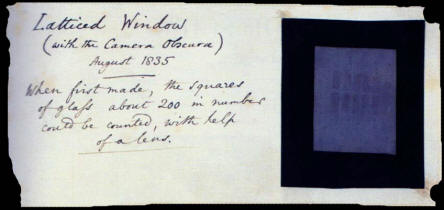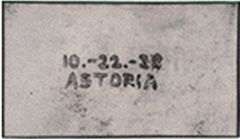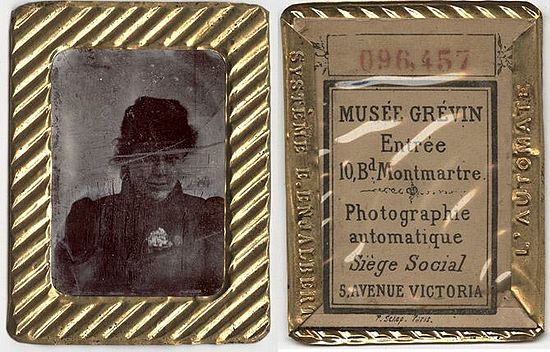First photo |
|||||
1. The technology |
2. The human subject |
||||
First photo |
|||||
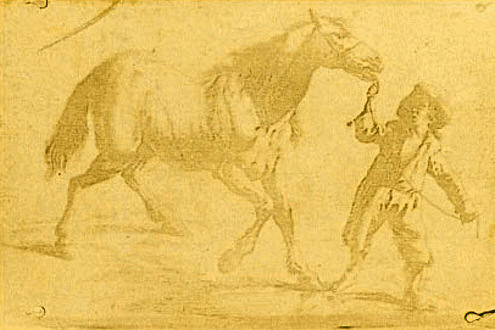 |
|||||
|
The earliest photographs were taken by Thomas Wedgwood (1771–1805), but none have survived, as he found no way to fix the images. [Eder] This is the oldest surviving photograph in the world. It is a photograph of a 17th century Flemish engraving, showing a man leading a horse. It was made by Nicéphore Niépce (1765–1833), the French inventor of photography, in 1825, with his heliography process. The Bibliothèque nationale de France bought it for €450,000 in 2002, deeming it a "national treasure". [Niépce's first successful permanent heliographic image, made in 1822, was of an engraving of Pope Pius VII. Made by means of bitumen of Judea on glass, it was accidentally smashed by General Poncet de Maupas, a relation to whom Niépce had presented it (see Gernsheim; The First Photograph—Heliography; Eder, pp200-4).] NB These heliographic images were made by contact printing, without the use of a camera. The image above has clearly been cropped. One or two uncropped images may be found on the internet, but they are smaller and less sharp. NB Wikimedia Commons has a photo said to have been taken at the Musée Nicéphore Niépce, of an exhibit there described as a heliograph on zinc dated 1823, entitled 'Paysage'. The image is quite unclear, and the exhibit's handwritten label difficult to read. The Museum's Catalog of Works describes this image as 6 x 7 cm on an 8.1 x 8.1cm plate, a reproduction of a drawing by contact, unknown base, unknown technique; the 1823 date is derived from the 1950 Catalog by L. Armand-Calliat.
|
|||||
|
|
|||||
First photo from nature, and first photo made with a camera |
|||||
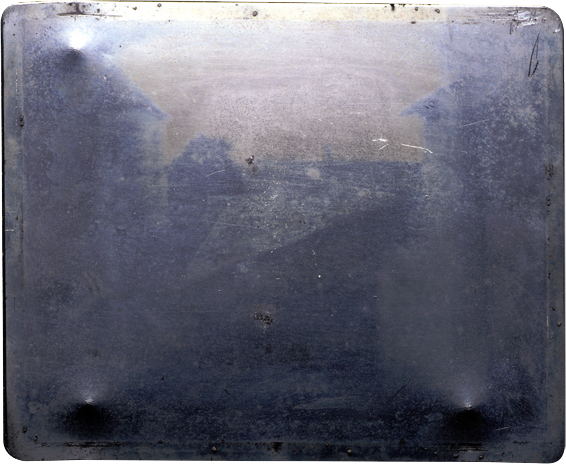 |
|||||
|
View from the Window at Le Gras (La cour du domaine du Gras) was the first successful permanent photograph from nature, created by Nicéphore Niépce in 1826/7 at Saint-Loup-de-Varennes. He had been attempting to secure this view since about April 1816. Niépce captured the photo with a camera obscura focused onto a sheet of 20 × 16 cm oil-treated bitumen. It represents the view of the courtyard of his house at Le Gras, taken from the window of his workroom. On the left side of the image is the pigeon-house (an upper loft in the family house). To the right of it is a pear-tree with a patch of sky showing through an opening in the branches. In the centre of the image is the slanting roof of the barn; the long building behind it is the bakehouse, with chimney. Another wing of the house is at the right side of the building. Owing to the 8-hour exposure, shadows appear on both sides of the courtyard. After an unsuccessful trip to Britain to attempt to interest the Royal Society in the process, Niépce gave the photo to the botanist Francis Bauer. It was publicly exhibited in 1898, but was thereafter long forgotten. The collector Helmut Gernsheim brought the photo to prominence again in 1952. In 1973 the University of Texas acquired the plate from Gernsheim, and it's now on display in Austin, at the Harry Ransom Humanities Research Center (catalogued as 964:0000:0001). [Batchen, The First Photograph, Sheehan & Zervigón].
|
|||||
|
|
|||||
First negative |
|||||
|
Image from theslideprojector, citing Mary Warner Marien (2006) Photography: A cultural History. 2nd edn. Upper Saddle River, NJ: Prentice Hall |
|||||
|
This image was created by William Henry Fox Talbot (1800–1877) in August 1835, using writing paper treated with silver chloride, exposed for perhaps two hours in a small wooden camera, then fixed with a solution of common salt. Talbot realised that the negative exposure allowed for the printing of multiple positive images.
|
|||||
|
|
|||||
First daguerreotype |
|||||
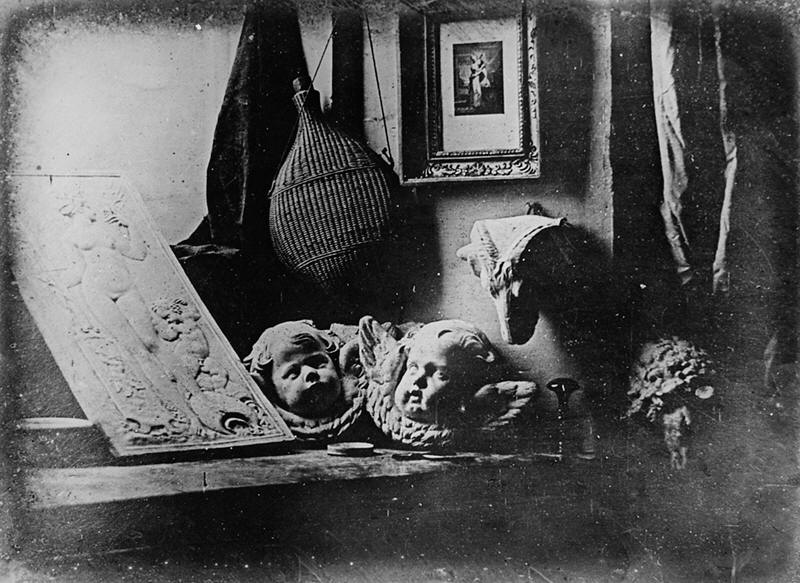 Louis Daguerre, L' Atelier de l'artiste, 1837; original held by the Société française de photographie, in Paris |
|||||
|
Although it was Talbot's invention that was to dominate the history of photography for most of the history of pre-digital photography, it would be misleading not to include the contribution of Louis Jacques Mandé Daguerre (1787–1851), who entered into partnership with Niépce and perfected a quite different process after the latter's death; this process, the daguerreotype, had substantial impact in the early years of photography. It's known that Daguerre had achieved success with his new process by 1835, and indeed we have a detailed description of an image seen in September 1836, depicting the hills of Montmartre. [Lowry & Lowry] The image above, however, is the earliest-surviving example of Daguerre's process, made on a silver-plated sheet of copper, 6½" × 8½" in size. It's also fair to say that this is the earliest-surviving photograph of which the subject is obvious. That said, it's understood that the original daguerreotype has for many years been only a blank mirror; the surviving image is a reproduction of a gelatin silver copy print made either in 1925 by Georges Potonniée or in 1936 by A. Dumas Satigny for Beaumont Newhall. [Sheehan & Zervigón] There were other photographic pioneers who developed their own processes independently of Niépce, Daguerre, or Talbot. None of these had any significant subsequent history, but it's only fair to mention the contributions of Hércules Florence (1804–1879), Hans Thøger Winther (1786–1851), and especially Hippolyte Bayard (1801–1887), whose own technique produced direct positives on paper, as early as 14 July 1839.
|
|||||
|
|
|||||
First panchromatic photograph |
|||||
|
For most of the first century of photography photographic plates and films were not sensitive to the whole spectrum of visible light. The introduction of panchromatic plates, which were, is therefore a significant milestone, but one not obviously marked by examples. The first panchromatic plate was produced by the Perutz Company in Munich under a 1903 patent obtained by Adolf Miethe (1862–1927) and Arthur Traube (1878–1948) for the use of the dye ethyl-red. However it wasn't until 1906, when Benno Homolka (1877–1949), a chemist at the Lucius and Bruning dye works at Hoschst discovered pinacyanol, that adequate red sensitivity was achieved. [Coote, p21] According to Eder [pp460-1], Hermann Wilhelm Vogel (1834–1898) created the first panchromatic plate in 1884, by use of a dye mixture he called 'azaline'; however Eder acknowledges that they were "feebly sensitive, less stable, and required strong light filters to subdue the blue", so perhaps for this reason Vogel's early efforts are no longer regarded as the first.
|
|||||
|
|
|||||
First flash photography |
|||||
|
Although intense artificial light sources, including in particular magnesium, had been used for photography since the late 1850s, true flash photography couldn't exist until more sensitive plates were available in the 1880s. In 1887 flashlight powder—Blitzlichtpulver—was invented in Germany by Adolf Miethe (1862–1927) and Johannes Gaedicke (b. 1835) of the astrophysical observatory at Potsdam. It was made from magnesium, potassium chlorate, and antimony trisulfide. [de.wikipedia.org/wiki/Adolf_Miethe, Frizot, p285] Presumably Miethe and Gaedicke succeeded in creating photographs using the new technique, but none have yet been located. Flash photography was quickly adopted elsewhere, most notably by Jacob August Riis (1849–1914) in 1888.
|
|||||
|
|
|||||
First halftone printing |
|||||
|
The last page of New York's Daily Graphic, 1873-12-02 |
|||||
|
William Henry Fox Talbot first suggested the use of screens for reproducing photographs in print in the early 1850s, but the first successful application was by Stephen H. Horgan (1854–1941), with this image of Steinway Hall in Manhattan. In another page of the same issue the announcement is made:
On the last page will be found a picture of Steinway Hall . . . . It is worthy of inspection, too, as being the first picture ever printed in a newspaper directly from a photograph. There has been here no intervention of artist or engraver, but the picture is transferred directly from a negative by means of our own patented process of 'granulated photography'. [Buckland, p165] The image was made by printing the negative on a mesh film and transferring it to zinc, a process developed by William Augustus Leggo (1830–1915) and George-Édouard Desbarats (1838–1893), and known as 'leggotype'. [Eder, pp627-8]
|
|||||
|
|
|||||
First wire photo |
|||||
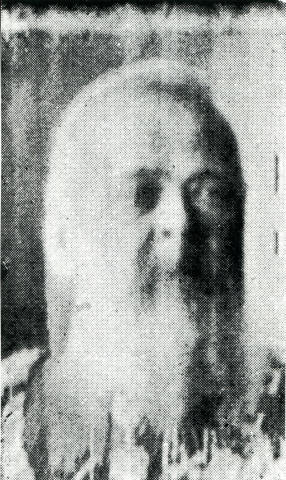 |
|||||
|
This photograph of Prinzregent Luitpold Karl Joseph Wilhelm Ludwig von Bayern was the first ever photograph successfully transmitted by wire. This was achieved by Dr Arthur Korn (1870–1945), of the University of Munich, on 17 October 1906. [Buckland, p261; Deusche Welle; New York Times] A rather cruder predecessor was the artograph invented in by Noah Steiner Amstutz (1864–1957), which was transmissible by telegraph in the form of narrow parallel lines. Story's example is below.
|
|||||
|
|
|||||
First photocopy |
|||||
|
|
|||||
|
Photocopying was invented by Chester Carlson (1906–1968), who set up a small lab in Astoria, Queens, New York, and hired a German physicist named Otto Kornei (1903–1993) to help with the lab work. It was here, in a rented second-floor room above a bar, where xerography (as it was first known) was invented, in October 1938. As Carlson told it:
I went to the lab that day and Otto had a freshly-prepared sulfur coating on a zinc plate. We tried to see what we could do toward making a visible image. Otto took a glass microscope slide and printed on it in India ink the notation '10-22-38 ASTORIA.' We pulled down the shade to make the room as dark as possible, then he rubbed the sulfur surface vigorously with a handkerchief to apply an electrostatic charge, laid the slide on the surface and placed the combination under a bright incandescent lamp for a few seconds. The slide was then removed and lycopodium powder was sprinkled on the sulfur surface. By gently blowing on the surface, all the loose powder was removed and there was left on the surface a near-perfect duplicate in powder of the notation which had been printed on the glass slide. Both of us repeated the experiment several times to convince ourselves that it was true, then we made some permanent copies by transferring the powder images to wax paper and heating the sheets to melt the wax. Then we went out to lunch and to celebrate. (The Story of Xerography)
|
|||||
|
|
|||||
First Polaroid instant photograph |
|||||
|
1944-03-13 test photograph, of Edwin Land |
|||||
|
Edwin Herbert Land (1909–1991) patented a camera and film for instant (self-developing) photography on 29 August 1946 (US patent number 2,435,720). He gave a lecture and demonstration to the Optical Society of America, at the Hotel Pennsylvania in New York, on 21 February 1947, and later the same year published 'A new one-step photographic process', based on that presentation. [J. Opt. Soc. Am. 37(2): 66-77]. The first published Polaroid picture, from this paper, is reproduced in Buckland [p183] But the test photograph above clearly predates this, and is thus the earliest so far located. [Bonanos, Baker Library, McElheny, The Land List] Commercially, Polaroid photography in sepia was available from 1948, black and white from 1950, peel-apart colour in 1963, and non-peel-apart or 'integral' colour from 1972. [McElheny: 180]
|
|||||
|
|
|||||
First photobooth |
|||||
|
The patent for the first automated photography machine was filed in 1888 by William Pope and Edward Poole of Baltimore. It was probably never built. The first known really working photographic machine was produced by the French inventor T. E. Enjalbert in March 1889. It was shown at the Paris World Fair of 1889. The first commercially successful automatic photographic apparatus was the 'Bosco', invented by Conrad Bernitt of Hamburg (patented 16 July 1890). All these early machines produced ferrotypes.
Tintype photobooth portrait, Enjalbert process; private collection of Jack and Beverly Wilgus; Luminous-Lint LL/84158 [paywalled] The modern concept of photo booth with (later) a curtain originated with Anatol Josepho (1894–1980), who emigrated from Russia to the USA in 1923. The first photo booth appeared in 1925 on Broadway in New York City. For 25 cents the booth took, developed and printed eight photos, a process taking roughly ten minutes. In the first six months after the booth was erected, it was used by 280,000 people.
|
|||||
|
|
|||||
First digital photo |
|||||
 |
|||||
|
Generally accepted as the first ever digital image is the scan by Russell Kirsch (1929–2020) of a photograph of his three-month-old son Walden. It was a 5cm by 5cm image, just 176 pixels on a side, made in the spring of 1957, with a rotating drum scanner built and programmed for the purpose, at the National Bureau of Standards (NBS, now known as the National Institute of Standards and Technology) in Washington, DC. [NIST] The first photograph taken on a digital camera was made by Steven Sasson (b. 1950), who had constructed the digital circuitry from scratch, and based the camera around a 100 x 100 array device (10k pixels, or .01 Mp) made by the Fairchild Corporation. The camera was developed in late 1974, and the first photograph taken in December 1975. According to Sasson, "It was shown on a black and white television and it was recorded on a digital cassette tape, like an audio cassette tape but it was digital signals, and when it was read off it was read off into a home made frame store because there were no pc's at that time." [Williams] The picture was of a lab assistant who had been persuaded to pose for the purpose. The image took 23 seconds to record onto the cassette and another 23 seconds to read off a playback unit onto a television. "You could see the silhouette of her hair," Sasson said, but her face was a blur of static. "She was less than happy with the photograph and left, saying 'You need work,' " he said. But he already knew the solution. By simply reversing a set of wires, the assistant's face was restored. Whether the image itself survives is not clear. [Dobbin] Steve Sasson himself tells the story in a George Eastman house video.
The first JPG file was a scan of a the top third of a Playboy centrefold of Lena Soderberg (née Sjööblom) from the November 1972 issue, which was adopted as the first test image in the development of the JPEG compression format, in June or July of 1973. [Hutchinson, The Lenna Story] [This is the very centrefold that is seen briefly in Woody Allen's 1973 Sleeper (roughly 16 min into the film).]
|
|||||
|
|
|||||
First optogram |
|||||
 |
|||||
|
The similarity between a camera and an eye is obvious, and apparently, even as early as the mid 17th century, an experimenter had observed a fleeting image on the retina of a dissected frog. In the 1870s, the German physiologist Wilhelm Kühne (1837–1900) discovered that rhodopsin, a photosensitive pigment in the rods of the retina, could be 'fixed' long enough for the image to be photographed. His most successful optogram (as the image was called) was obtained from an albino rabbit, with its head fastened to face a barred window. The rabbit's head was covered for several minutes to allow rhodopsin to accumulate on the retina. It was then uncovered for three minutes to expose it to the light, then decapitated and its eyeball sliced from top to bottom. The rear half of the eye was placed in an alum solution to fix the bleached rhodopsin, which resulted in a distinct image of the barred windows. The image shown dates from 1877 and shows, successively, a rabbit retina showing no image, a retina from a rabbit that had been compelled to stare at a seven-paned arch window, and the retina of a rabbit that stared at three side-by-side windows. No successful images taken from a human eyeball survive, though this was attempted in 1877 and apparently achieved in 1880, with an eyeball taken from a guillotined murderer; in the latter case a crude drawing of the image survives, but it seems unlikely the image depicted anything at all, given that the victim was blindfolded at the time of the execution. [Fessenden; Fitzharris; Ogbourne]
|
|||||
First photo finish photography |
|||||
|
Photo finish photography requires a completely different
photographic technique from conventional photography. The camera has
no shutter and uses a very narrow aperture field, while the film
itself advances continuously at approximately the same speed as the
moving subject, but in the opposite direction. So while a
conventional photograph shows a variety of locations at a fixed
moment in time, photo finish photography swaps the time and space
dimensions, showing a variety of times at a fixed location. Digital
photo finish cameras record in essentially the same way, but using a
1-dimensional array sensor to take 1-pixel-wide sequential images of
the finish line. The earliest predecessor to the photo finish camera was employed by Ernest Marx, who claimed to have made the first single-exposure finish line photographs in the 1880s by panning his camera as horses passed the finish line, using a trip wire. There are no surviving examples of Marx's photographs, but sketch copies reproduced in a contemporary magazine suggest the earliest of these may have been made in 1886. The earliest actual survivor of this phase of photo finish photography is that taken by J.C. Hemment, of the Salvator-Tenny Match Race at Sheepshead Bay, New York, on 25 June 1890 (reproduced in Belden-Adams). The technique didn't fully meet requirements, so better alternatives were sought, over time. Robert Capon, a British inventor, patented a camera in 1926 that was essentially "the sire of the modern racecourse camera", although it was never used at a race track, instead being used to photograph automobiles and aircraft in motion. A camera specifically for race track use was developed by Lorenzo Del Riccio in 1937, and debuted at the Del Mar Turf Club in California. It doesn't appear that any photo finish images from 1937 have survived. Del Riccio's patent, from 1 June 1943, may be found here. The best and most comprehensive source on this is Belden-Adams.
|
|||||
|
|
|||||
| © 2009–2025 Benjamin S. Beck |
If you know of any earlier examples, please contact me.
|
|
